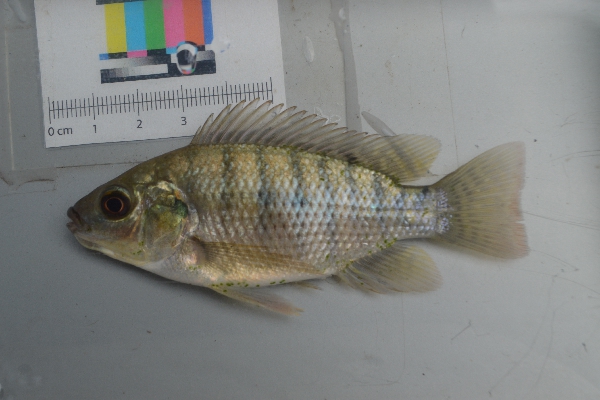Common names:
Nile tilapia
Lunyankole: Mahere Lugungu: Nsogola Alur: Zogoro Jonam: Oro General: Ngege
Taxonomic tree
Kingdom: Animalia
Phylum: Chordata
Class: Actinopterygii (ray-finned fish)
Order: Cichliformes (Cichlids)
Family: Cichlidae (Cichlids)
Genus: Oreochromis
Species: Oreochromis niloticus (Linnaeus, 1758)
Number of Occurrancies: 1655
Etymology(based on Scharpf & Lazara, 2019)
- Oreochromis: oreos, mountains, referring to Mt. Kilimanjaro (Tanzania), location of O. hunteri, type species; chromis, possibly derived from chroemo (to neigh), referring to a drum (Sciaenidae) and its ability to make noise, later expanded to embrace cichlids, damselfishes, dottybacks and wrasses (all perch-like fishes once thought to be related), often used in the names of African cichlid genera following Chromis (now Oreochromis) mossambicus Peters 1852.
- niloticus: –icus, belonging to: Nile River, referring to native distribution in the Nile River valley
Synonyms:click here to view synonyms
Type locality: Nile River. Holotype at NRM
General identification features for "tilapiine" cichlids
- A single nostril on each side of the head; dorsal fin with contineous spinous and soft-rayed parts; lateral line interrupted(with anterior superior part and posterior inferior part)
- Cycloid scales
- Tilapia mark (dark spot at the posterior end of the dorsal fin) in juveniles
Distinguishing characters for the genus
- More gillrakers (usually 18-28) on the first gill arch
- Outermost teeth bicuspid in young and in adult females, but in mature males of several species becoming unicuspid by wear or replacement: Note that O. niloticus is an exception; some or all teeth of outermost row are replaced by tricuspids
- Genital papilla of male and female well developed
- Maternal mouth-brooders, usually with marked sexual dimorphism and discromatism (sexual differences related to size and color respectively) at breeding time; males have distinctive and conspicuous breeding colors and are often bigger than females
- Jaws that are greatly enlarged as fish matures, especially males
- Scales of belly smaller, in some species much smaller, than those of flanks; transition between the two sizes gradual or abrupt
- Pharyngeal teeth ranging from relatively coarse, with the length of the lower dentigerous area approximately equal to that of the blade or a little longer, to very fine on a reduced dentigerous area.
Distinguishing characte for the species
- Caudal fin with numerous wavy vertical bars (Diagnostic)
- Colour is variable depending on habitat: Typically, greyish ground-color, darker above; faint traces of 6 or seven dark vertical bars on the flanks and caudal peduncle.In breeding males, the ventral surface of the body, anal, dorsal and pelvic fins are black, the head and the flanks are flushed with red.
Additional remarks: This species has been introduced in many systems worldwide and forms an important component both in capture fisheries and aquaculture.
Distribution in Uganda: The most widely distributed species in Uganda; Occurs naturally in Lakes Edward, George and Albert, and in many crator lakes in western Uganda. However the species has been widely introduced in many other systems, notably Lakes Victoria and Kyoga basins (see the map) in the 1950s.
Occurence: Native/Introduced
Habitat: Benthopelagic; common in waters less than 20 m deep in sheltered gulfs and bays with soft muddy bottom.
Feeding: Omnivorous, feeding on phytoplankton (both in suspension or bottom deposits), insects, crustaceans
Biology: The species can grow to different sizes, mature at different rates and alter their fecundity and size of oocytes depending on environment, level of stress from fishing and predation and habitat changes (Bwanika et al., 2004). Sizes reaching between 60 and 70 cm are not uncommon in big lakes. Reproduction takes place throughout the year, peaking during rainy season, with males building nests mainly over hard bottom composed of sand and gravel. The species is a maternal mouth brooder and juveniles are common in shallow sheltered areas. Size at maturity is variable and depends on sex; in Lake Victoria, size at first maturity ranges between 15 and 24 cm TL, while size at 50% maturity ranges between 22-25 cm TL for females and 31-35 cm TL for males (Njiru et al., 2006). Fecundity ranges between 340-3706 eggs in fishes from 17-57 cm TL (Witte and van Densen, 1995). The fish attains 25 cm TL in two years (Bwanika et al., 2006).
Economic importance/End use: Oreochromis niloticus is the third most important commercial fish species in capture fisheries in Uganda after the Lates niloticus and Rastrineobola argentea. The species is also the second most important in regard to aquaculture after the Clarias gariepinus and is most preferred among the commercially important species for consumption by the lakeside communities. In Lake Victoria (Ugandan part), for instance, annual catches of Nile tilapia are worth $90 million from the direct sales at the landing sites (NaFIRRI 2014, unpublished data).
IUCN conservation status: click here to view IUCN status
Threats: Fishing; destruction of inshore fringing vegetation where the species breeds
Main references
- Greenwood PH. 1966. The fishes of Uganda. The Uganda Society, Kampala. 131 pages.
- Twewavas E. 1983. Tilapiine fishes of the genera Sarotherodon, Oreochromis and Danakilia. British Museum (Natural History), London. 604 pages
- Sharpf C, Lazara J.K. 2019. Fish Name Etymology Database v5. www.etyfish.org
- Witte F & van Densen W.L.T. 1995. Fish Stocks and Fisheries of Lake Victoria: a handbook for field observations. Samara Publishing Limited, Netherlands
- Bwanika G. N., Makanga B., Kizito Y., Chapman L. J. & Balirwa J. (2004) Observations on the biology of Nile tilapia, Oreochromis niloticus L., in two Ugandan crater lakes. Afr. J. Ecol. 42, 93–101.
- Bwanika G. N., Chapman L. J. & Murie D. J. (2006). Comparative age and growth of Nile tilapia (Oreochromis niloticus L.) in lakes Nabugabo and Wamala, Uganda. Hydrobiologia 589(1):287-301.





" indeed, wonderful information. "
June 22, 2023, 4:07 p.m.